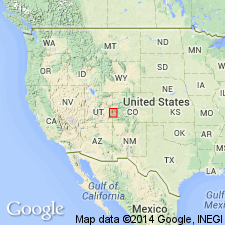
- Usage in publication:
-
- Sewemup member*
- Modifications:
-
- Original reference
- Dominant lithology:
-
- Siltstone
- Shale
- Sandstone
- AAPG geologic province:
-
- Piceance basin
Summary:
Pg. 1839-1840, 1842, 1846-1847. Sewemup member of Moenkopi formation. Chiefly chocolate-brown fissile siltstone or shale with subordinate interbedded light-brown fine-grained sandstone; gypsum present throughout member, mainly as interstitial cement or cross-cutting veinlets near base and in discrete thin nodular beds near top; some beds of light maroon coarse-grained sandstone; locally sandstone is conglomeratic. Thickness 0 to about 450 feet. Cut out toward Uncompahgre Plateau, and locally over salt anticlines and small folds peripheral to Fisher Valley by angular unconformity at base of overlying Chinle formation; in Sinbad Valley, overlapped by Pariott member (new) toward axis of anticline. Conformably overlies and intertongues with Ali Baba member (new). Underlies Pariott member (new). Age is Early and Middle(?) Triassic.
Type section: east side of Sinbad Valley, in sec. 15, T. 49 N., R. 19 W., Mesa Co., southwestern CO. Named from Sewemup Mesa which forms east wall of Sinbad Valley. Extends into southeastern UT.
Source: US geologic names lexicon (USGS Bull. 1200, p. 3538-3539).
For more information, please contact Nancy Stamm, Geologic Names Committee Secretary.
Asterisk (*) indicates published by U.S. Geological Survey authors.
"No current usage" (†) implies that a name has been abandoned or has fallen into disuse. Former usage and, if known, replacement name given in parentheses ( ).
Slash (/) indicates name conflicts with nomenclatural guidelines (CSN, 1933; ACSN, 1961, 1970; NACSN, 1983, 2005, 2021). May be explained within brackets ([ ]).

